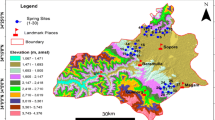Abstract
The Niangziguan Spring is one of the largest karst springs in northern China and water in this spring area is the main water-supply source for people in Yangquan City for daily life, industrial processes and agricultural production. However, decreasing groundwater levels and growing waterpollution issues have been observed recently. Therefore, the objective of this study was to conduct a systematic analysis of water-flow reduction and water-quality deterioration of the Niangziguan Spring. The results show that various wastewater sources upstream of the spring, such as coal mining, and urban industrial and domestic effluents, have contributed to the deterioration of the Niangziguan Spring water quality. A mathematical model known as the one-order one-variable grey differential equation model GM(1,1) was employed to evaluate the contribution of climate change versus human activities potentially affecting the reduction of spring-water flow. The calculations for the period from 1979 to 2006 suggest that a contribution of human activities to water-flow reduction was 2.5 times greater than those that can be attributable to climate change. The research results obtained as presented in this paper can provide a scientific basis for rational exploitation of karst-water resources and environmental protection in this karst area of northern China.


(modified from He et al. 2019)

(modified from Hao et al. 2012)




Similar content being viewed by others
References
Bai YZ (2010) Exploitation and protection of karst groundwater in Niangziguan Spring area. Shanxi Water Resour 26(08):20–21 (in Chinese)
Chang XY, Wang BB, Yan Y et al (2018) Characterizing effects of monsoons and climate teleconnections on precipitation in China using wavelet coherence and global coherence. Clim Dyn 52:5213–5228
Du X (2009) Study on the influencing factors of karst-spring discharge in north China. Shanxi University (in Chinese)
Fan YH, Huo XL, Hao YH et al (2013) An assembled extreme value statistical model of karst-spring discharge. J Hydrol 504:57–68
Glazier DS (2014) Reference module in earth systems and environmental sciences. Elsevier Inc, Amsterdanm, pp 89–115
Guo QH, Wang YX, Ma T et al (2005) Variation of karst-spring discharge in recent five decades as an indicator of global climate change: a case study at Shanxi, northern China. Sci China Ser D Earth Sci 48:2001–2010
Hao Y, Liu G, Li H et al (2012) Investigation of karstic hydrological processes of Niangziguan Spring (North China) using wavelet analysis. Hydrol Process 26:3062–3069
Hao YH, Cao BB, Chen X et al (2013) A piecewise grey system model for study the effects of anthropogenic activities on karst hydrological processes. Water Resour Manage 27:1207–1220
Hao YH, Wang YJ, Zhu Y et al (2009) Response of karst-spring to climate change and anthropogenic activities: the Niangziguan Spring, China. Progress Physical Geography 33(05):634–649
He XD, Wu JH, Guo WY (2019) Karst-spring protection for the sustainable and healthy living: the examples of Niangziguan Spring and Shuishentang Spring in Shanxi, China. Exposure Health 11:153–165
Kresic N, Stevanovic Z (2010) Groundwater hydrology of spring: engineering, theory, management and sustainability. Acta Carsologica. pp. 543–565
Li ZJ, Yang QC, Wang LC et al (2017) Application of RBFN network and GM (1,1) for groundwater level simulation. Appl Water Sci 7:3345–3353
Lu Y (2006) Karst-water resources and geo-ecology in typical regions of China. Environ Earth Sci 51(5):695–699
Orhan G, Celalettin S (2011) Influence of climate change on shallow groundwater resources: the link between precipitation and groundwater levels in alluvial systems. Climate Change Effects Water Resources 3:225–233
Pai TY, Wu RS, Chen CH et al (2014) Predicting hardness of four groundwater monitoring stations in Kaohsiung City of Taiwan Using Seven Types of GM(1,1) Model. Adv Mater Res 905:314–317
Shahbaz M, Farhani S, Ozturk I (2015) Do coal consumption and industrial development increase environmental degradation in China and India? Environ Sci Pollut Res 22:3895–3907
Yang XF, Gao XB, Chen D (2009) Evaluation on ground water pollution in Niangziguan karst spring. Environ Sci Surv 28(04):65–67 (in Chinese)
Yuan DX, Zhu DH, Weng JT (1994) Chinese karst science. Geological Publishing House. pp. 1–35 (in Chinese)
Zhang J, Hao YH, Hu BX et al (2017) The effects of monsoons and climate teleconnections on the Niangziguan Karst-Spring discharge in North China. Clim Dyn 48:53–70
Zhang XB, Li X, Gao XB (2016) Hydrochemistry and coal mining activity induced karst-water quality degradation in the Niangziguan karst-water system, China. Environ Sci Pollution Res 23(07):6286–6299
Zhao CH, Liang YP, Lu HP (2013) Fuzzy evaluation of karst-water vulnerability in Niangziguan Spring Area. J China Hydrol 5:52–57 (in Chinese)
Acknowledgments
This study was supported by the National Natural Science Foundation of China (41372297), the Natural Science Foundation of Shandong Province (ZR2020KE004), the Open Foundation of the Key Laboratory of Geological Hazards on the Three Gorges Reservoir Area (China Three Gorges University), Ministry of Education (2017KDZ03), the Open Foundation of Geo-Engineering Surveying Institute of Qingdao (2019-QDDZYKF02) and the Cooperative Innovation Center of Engineering Construction and Safety in the Shandong Blue Economic Zone.
Author information
Authors and Affiliations
Corresponding author
Additional information
Publisher's Note
Springer Nature remains neutral with regard to jurisdictional claims in published maps and institutional affiliations.
Rights and permissions
About this article
Cite this article
Keqiang, H., Yuanyuan, G., Lu, G. et al. A systematic analysis of water flow reduction and water-quality deterioration of the Niangziguan Spring area in northern China. Environ Earth Sci 80, 347 (2021). https://doi.org/10.1007/s12665-021-09628-0
Received:
Accepted:
Published:
DOI: https://doi.org/10.1007/s12665-021-09628-0




